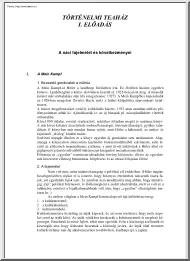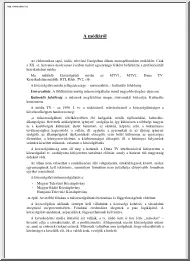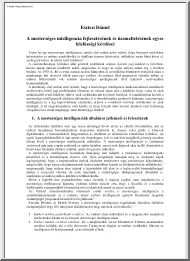Comments
No comments yet. You can be the first!
What did others read after this?
Content extract
A Chord konduktancia -egyenlet The Chord Conductance equation I= +60 Na+ ∆U R g= 1 R I Cl = ( Em − ECl ) g Cl ≈ 0 I Na = ( Em − E Na ) g Na I K = ( Em − E K ) g K − − + + 0 -70 Em -90 K+ − + + + + Ohm’s law: I = current U = electrical potential R = resistance g = conductance Em = membrane potential EK = equilibrium potential for K ENa = equilibrium potential for Na In the steady-state (no change in current), the sum of all individual currents through the membrane (i.e, through individual channels) are assumed to be zero. MEANING: NO NET ION CHARGE MOVES ACROSS THE MEMBRANE. (INa+) + (IK+) + (ICl-) + (ICa2+) = 0 If we say that the total conductance gT is the sum of all conductances, then: gT = (gNa+) + (gK+) + (gCl-) + (gCa2+) the above can be solved for the membrane potential. Relative conductances of the membrane under RESTING conditions gK+ > gNa+ > gCl- > gCa2+ (gCl- and gCa2+ are really small and are usually not considered
in calculations) The Chord Conductance Equation can be used to calculate Em if the conductances of each ion and their Nernst potentials are known. Note: This equation predicts that if a particular ion has a high conductance relative to the others, the Em will be near the Nernst potential of that ion. Thus, if a membrane is permeable to only K+ (i.e, gK+ is high and close to gT), then the last 3 terms of the above equation will drop out and Em = EK+. . But the best approximation is achieved when considering Na+ and K+ +60 Na+ 0 -70 Em -90 K+ A chord konduktancia egyenlet The chord conductance equation I= +60 Na+ ∆U g= R 1 R I Cl = ( Em − ECl ) g Cl ≈ 0 I Na = ( Em − E Na ) g Na I K = ( Em − E K ) g K − − + + + 0 + -90 K+ + + + Em + I Na + I K = 0 ( Em − E Na ) g Na = −( Em − E K ) g K g Na gK Em = EK + E Na g K + g Na g K + g Na + -70 − + + + + + + + + + 100 1 Em = EK + + E Na + 100 + 1 100 + 1 A chord
konduktancia egyenlet The chord conductance equation + + +60 Na+ 0 -70 Em -90 K+ Em = EK+ A chord konduktancia egyenlet Na+ csatorna blokkoló után Chord conductance equation after blockade of Na+ channels Mechanisms for opening Ion Channels – Ion channels open in response to: • 1: a voltage stimulus – Known as voltage-gated channels • 2: Binding of a ligand – Known as ligand-gated channels • 3: a mechanical stimulus – Known as mechanically gated channels Control of Ion Channels Patch Clamp Technique • Lehetővé teszi a membránon keresztüli ionáramok és feszültség, valamint a membránkapacitás mérését. • It allows to measure transmembrane ion currents and voltages as well as changes in membrane capacitance. Single Channel Recording Microelectrodes Mikroelektródák Looking through the microscope Kép a mikroszkóp alatt Cell-attached Gigaseal Configurations Konfigurációk Single Channel Recording Egyes
ioncsatorák vizsgálata Whole Cell Recording Teljes sejt mérés AZ AKCIÓS POTENCIÁL KIALAKULÁSA DEVELOPMENT OF ACTION POTENTIAL A SZINAPTIKUS ÁTTEVŐDÉS SYNAPTIC TRANSMISSION Dr. Zsembery Ákos AKCIÓS POTENCIÁL ACTION POTENTIAL Gyors membrán potenciál változás, melyet a nyugalmi potenciálhoz való visszatérés követ Rapid change in the membrane potential followed by a return to the resting membrane potential Különböző típusú akcióspotenciálok Different Types of Action Potentials Az akcióspotenciál fázisai Phases of the Action Potential Action Potential and Ion Conductivity in Nerve and Skeletal Muscle Cells Nerve Cells • have a resting potential - set by a constitutively active K+-selective channel (leak K+ channel) • have voltage-gated Na+ channels • have voltage-gated K+ channels Az idegsejtek akciós potenciáljának kialakulásában a feszültség-függő Na+ és K+ csatornák játszák a főszerepet Voltage-gated Na+
and K+ channels are the major players in generating nerve action potentials Feszültség-függő Na+ csatornák Voltage-gated Na+ channels • Very few types • Mostly one role – Initiate and propagate action potentials • Structure well known • Three types of conformational state controlled by membrane voltage (resting, activated and inactivated) Na+ Channel Structure I II III IV Outside + + + + + + + + + + + + Inside NH2 COOH Na+ Channel Conformations αm(Vm) αh(Vm) βm(Vm) βh(Vm) Resting Activated Inactivated Non-conducting conformation(s) Conducting conformation Another non-conducting conformation (at negative potentials : -90 mV) (shortly after more depolarized potentials : -90 - +35 mV) (a while after more depolarized potentials : -90 - +35 mV)) Na+ Channel Gating Na+ Na+ Na+ Na+ Na+ Na+ Na+ Na+ Na+ Na+ Na+ Na+ Na+ Outside Inside Na+ Na+ Na+ Na+ -15 mV Na+ -60 mV Feszültség-függő K+ csatornák Voltage-gated K+
channels • Many types – E.g nerve K+ channels • Many roles – E.g action potential repolarization • Structure is known – Four subunits form homotetramer • Two types of conformational states controlled by membrane potential (closed and open) Two Conformations α(Vm) β(Vm) Closed Open Non-conducting conformation(s) Conducting conformation (at negative potentials) (at more positive potentials) Voltage Dependent Gating Outside S1 S2 S3 S4 S5 S6 Inside HO2C H 2N + + + + + + LRVIRLVRVFRIFKLSRHS K+ Channel Gating K+ K+ K+ K+ K+ K+ K+ Outside Inside K+ K+ K+ -60 mV mV -15 K+ K+ K+ K+ K+ K+ K+ K+ The Action Potential: Na+ and K+ Channels VNa (near +70 mV) Most Na channels open K channels closed 0 mV Membrane Voltage (mV) Na channels closed (Not inactivated) Na channels opening Na channels inactivating K channels opening K channels closing VK (near -90 mV) Na channels un-inactivating Most K channels open Many Na channels
inactivated The Nerve Action Potential • is a transient reversal of the polarity of the membrane potential • has a rising phase (depolarization) caused by the opening of Na+ channels • has an overshoot that approaches VNa • has a falling phase (repolarization) caused by opening of K+ channels and inactivation of Na+ channels A TEA és a TTX hatásai az akciós potenciálra Effects of TEA and TTX on the action potential TEA: Tetraethylammonium TTX: tetrodotoxin Refrakter fázisok Refractoriness A küszöbinger változása a refrakter fázisok alatt Changes in Threshold During Refractory Periods The Nerve Action Potential • has an absolute refractory period because most Na+ channels are first rapidly opening and then rapidly becoming inactivated • has a relative refractory period because some Na+ channels are inactivated and some K+ channels are open • propagates in one direction along axons through the sequential action of Na+ channels
(“unidirectional”)
in calculations) The Chord Conductance Equation can be used to calculate Em if the conductances of each ion and their Nernst potentials are known. Note: This equation predicts that if a particular ion has a high conductance relative to the others, the Em will be near the Nernst potential of that ion. Thus, if a membrane is permeable to only K+ (i.e, gK+ is high and close to gT), then the last 3 terms of the above equation will drop out and Em = EK+. . But the best approximation is achieved when considering Na+ and K+ +60 Na+ 0 -70 Em -90 K+ A chord konduktancia egyenlet The chord conductance equation I= +60 Na+ ∆U g= R 1 R I Cl = ( Em − ECl ) g Cl ≈ 0 I Na = ( Em − E Na ) g Na I K = ( Em − E K ) g K − − + + + 0 + -90 K+ + + + Em + I Na + I K = 0 ( Em − E Na ) g Na = −( Em − E K ) g K g Na gK Em = EK + E Na g K + g Na g K + g Na + -70 − + + + + + + + + + 100 1 Em = EK + + E Na + 100 + 1 100 + 1 A chord
konduktancia egyenlet The chord conductance equation + + +60 Na+ 0 -70 Em -90 K+ Em = EK+ A chord konduktancia egyenlet Na+ csatorna blokkoló után Chord conductance equation after blockade of Na+ channels Mechanisms for opening Ion Channels – Ion channels open in response to: • 1: a voltage stimulus – Known as voltage-gated channels • 2: Binding of a ligand – Known as ligand-gated channels • 3: a mechanical stimulus – Known as mechanically gated channels Control of Ion Channels Patch Clamp Technique • Lehetővé teszi a membránon keresztüli ionáramok és feszültség, valamint a membránkapacitás mérését. • It allows to measure transmembrane ion currents and voltages as well as changes in membrane capacitance. Single Channel Recording Microelectrodes Mikroelektródák Looking through the microscope Kép a mikroszkóp alatt Cell-attached Gigaseal Configurations Konfigurációk Single Channel Recording Egyes
ioncsatorák vizsgálata Whole Cell Recording Teljes sejt mérés AZ AKCIÓS POTENCIÁL KIALAKULÁSA DEVELOPMENT OF ACTION POTENTIAL A SZINAPTIKUS ÁTTEVŐDÉS SYNAPTIC TRANSMISSION Dr. Zsembery Ákos AKCIÓS POTENCIÁL ACTION POTENTIAL Gyors membrán potenciál változás, melyet a nyugalmi potenciálhoz való visszatérés követ Rapid change in the membrane potential followed by a return to the resting membrane potential Különböző típusú akcióspotenciálok Different Types of Action Potentials Az akcióspotenciál fázisai Phases of the Action Potential Action Potential and Ion Conductivity in Nerve and Skeletal Muscle Cells Nerve Cells • have a resting potential - set by a constitutively active K+-selective channel (leak K+ channel) • have voltage-gated Na+ channels • have voltage-gated K+ channels Az idegsejtek akciós potenciáljának kialakulásában a feszültség-függő Na+ és K+ csatornák játszák a főszerepet Voltage-gated Na+
and K+ channels are the major players in generating nerve action potentials Feszültség-függő Na+ csatornák Voltage-gated Na+ channels • Very few types • Mostly one role – Initiate and propagate action potentials • Structure well known • Three types of conformational state controlled by membrane voltage (resting, activated and inactivated) Na+ Channel Structure I II III IV Outside + + + + + + + + + + + + Inside NH2 COOH Na+ Channel Conformations αm(Vm) αh(Vm) βm(Vm) βh(Vm) Resting Activated Inactivated Non-conducting conformation(s) Conducting conformation Another non-conducting conformation (at negative potentials : -90 mV) (shortly after more depolarized potentials : -90 - +35 mV) (a while after more depolarized potentials : -90 - +35 mV)) Na+ Channel Gating Na+ Na+ Na+ Na+ Na+ Na+ Na+ Na+ Na+ Na+ Na+ Na+ Na+ Outside Inside Na+ Na+ Na+ Na+ -15 mV Na+ -60 mV Feszültség-függő K+ csatornák Voltage-gated K+
channels • Many types – E.g nerve K+ channels • Many roles – E.g action potential repolarization • Structure is known – Four subunits form homotetramer • Two types of conformational states controlled by membrane potential (closed and open) Two Conformations α(Vm) β(Vm) Closed Open Non-conducting conformation(s) Conducting conformation (at negative potentials) (at more positive potentials) Voltage Dependent Gating Outside S1 S2 S3 S4 S5 S6 Inside HO2C H 2N + + + + + + LRVIRLVRVFRIFKLSRHS K+ Channel Gating K+ K+ K+ K+ K+ K+ K+ Outside Inside K+ K+ K+ -60 mV mV -15 K+ K+ K+ K+ K+ K+ K+ K+ The Action Potential: Na+ and K+ Channels VNa (near +70 mV) Most Na channels open K channels closed 0 mV Membrane Voltage (mV) Na channels closed (Not inactivated) Na channels opening Na channels inactivating K channels opening K channels closing VK (near -90 mV) Na channels un-inactivating Most K channels open Many Na channels
inactivated The Nerve Action Potential • is a transient reversal of the polarity of the membrane potential • has a rising phase (depolarization) caused by the opening of Na+ channels • has an overshoot that approaches VNa • has a falling phase (repolarization) caused by opening of K+ channels and inactivation of Na+ channels A TEA és a TTX hatásai az akciós potenciálra Effects of TEA and TTX on the action potential TEA: Tetraethylammonium TTX: tetrodotoxin Refrakter fázisok Refractoriness A küszöbinger változása a refrakter fázisok alatt Changes in Threshold During Refractory Periods The Nerve Action Potential • has an absolute refractory period because most Na+ channels are first rapidly opening and then rapidly becoming inactivated • has a relative refractory period because some Na+ channels are inactivated and some K+ channels are open • propagates in one direction along axons through the sequential action of Na+ channels
(“unidirectional”)





 Just like you draw up a plan when you’re going to war, building a house, or even going on vacation, you need to draw up a plan for your business. This tutorial will help you to clearly see where you are and make it possible to understand where you’re going.
Just like you draw up a plan when you’re going to war, building a house, or even going on vacation, you need to draw up a plan for your business. This tutorial will help you to clearly see where you are and make it possible to understand where you’re going.